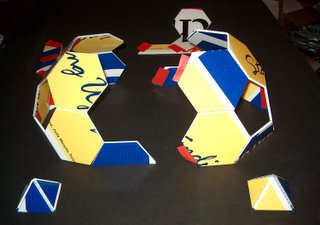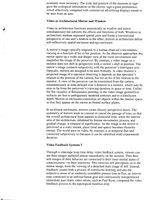
wifi video stills from test transmission.
Brett,
Just to clarify, The TAZ is structurally connected to the c60, Buckminsterfullerene molecule. Historically --- I guess there is a connection with all Utopian architectural design steming from Bucky's balls....what fertile balls they were. I just have a problem with geodesic domes because they're done to death within the context of utopian spaces.
Lets keep the talk open...I just had to say something.
I like the definition of art you mentioned in your previous post by
Lawrence Weiner, "A work of art can be made the artist, or the by the receiver, or could not be made at all, according to the wishes of the eventual
receiver of the work". Here's a quote from Dan Graham, " An architectural code
both reflects and determines the social order of public/private space and the psychological sense of self". I'd like to pair that with the idea of autonomy.Do we succeed in allowing the interactive viewer a brief glimpse of autonomy?...is that the right question? Something Jamie might like to hear too. I think her self portraits in public spaces blurs the boundaries of contextual specificity defined by public spaces/architecture.
More to come
Temporary Autonomous Zone
The work of art known as the T.A.Z. is many things. It is Sculpture,
Installation, Time Art and performance and interactive.
What is it?
The T.A.Z. is a three dimensional structure with architectural history
based on the Geodesic dome.
The T.A.Z. is a physical and theoretical sculpture. Sometimes site
specific.
The T.A.Z. is a time art. The element of time comes from the video
camera transmission and participation of the audience for a recorded or
non-recorded period of time. If recorded then the transaction remains a
copy of a moment of time that exists as a single one-sided exchange. If both
parties participated in the exchange and choose to record the transmission or exchange then the recorded transmissions remain as a library. This library is then edited to show both sides of the transmission. The new
edited transmission becomes a new work of art.
The T.A.Z. is performative. Artist or non-artist perform with one
another in the form of communication. Communication is many things. It can be speech, writing, gestures or singing. One could curate others to perform in or around the T.A.Z. or respond to the T.A.Z.
In the 1970’s Joseph Beuys used a framework to make art in that he termed
Social Sculpture. Social Sculpture is a concept that art can and should
be a participatory and inderdisplinary process using thought, speech and
discussion as the main materials.
It was with this view that Beuys claimed everyone is an artist.
Beuys believed that all human beings are responsible for the shaping of a democratic and sustainable social order.
Social sculpture lifts the aesthetic from it’s confines within a speciafic sphere or media, relocating it within a collective, imaginative work space in which we can see, re-think and reshape our lives in tune with our creative potential. From Social sculpture research unit website?
The T.A.Z. does just that. It puts one in the imaginative work space.
This space allows one to create or communicate or do nothing.
>Robert.
>I'm trying to organize my thoughts a little more to
>contribute to the paper and discussion.
>Here is a start.
>more to come.
>Brett
>
Thoughts and questions about Temporary Autonomous Zones.
What do they do?
Is communication important?
Is architecture important?
Is performance important to the work?
Interaction/ interactive?
If participate or not. Is the artwork still artwork then?
How do Joseph Beuys, Lawrence Weiner, Thomas Hirschhorn. Dan Graham, Allen Kaprow and Robert Whitman.
Oldenburge and His store fronts. Installations The Street (1960) and The Store (1961.)
Fluxus
Kaprow’s large scale structures such as Kiosk and Apple Shrine.
Robert Filliou.
Whitman”s participatory frameworks and sets from 1958
Dan Graham pavilion-structure histories
Kiosks
Walter Benjamin’s arcade projects.
The rise of the new semiotic architecture or the 20’s and 30’s.
This new architecture of signs (rather than the architecture or social spaces and functions develops at the very moment when architectures traditional tasks to continue and enable the various social functions in public space. (e.g. labor and production, domestic and public leisure) were displaced by new tasks to organize space as media, in competition with, if not in execution of the interests of rising media and commodity culture.
Hirschhorn book.
Lawrence Weiner”
A work of art can be made the artist, or the by the receiver, or could not be made at all, according to the wishes of the eventual receiver of the work.



















